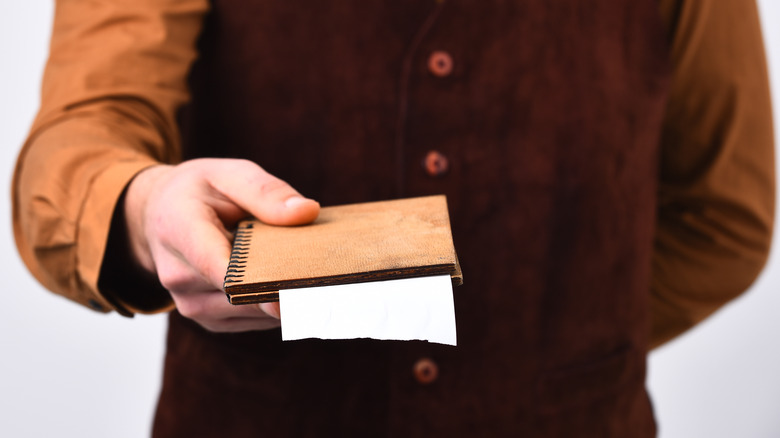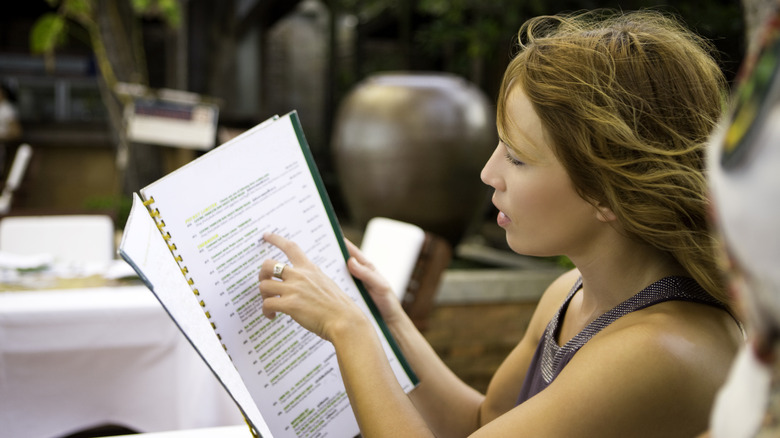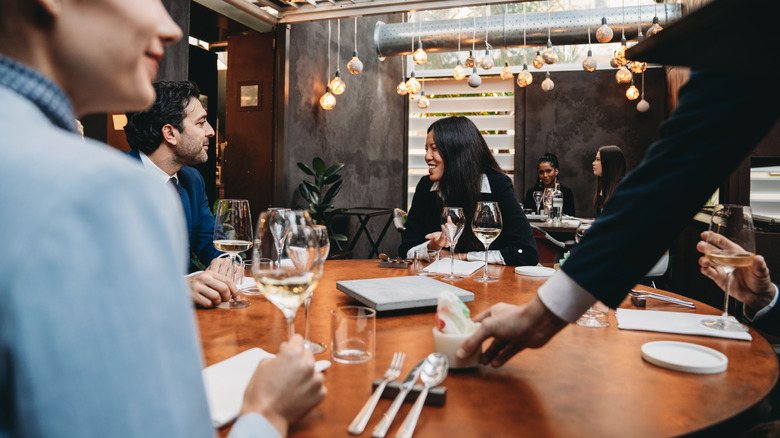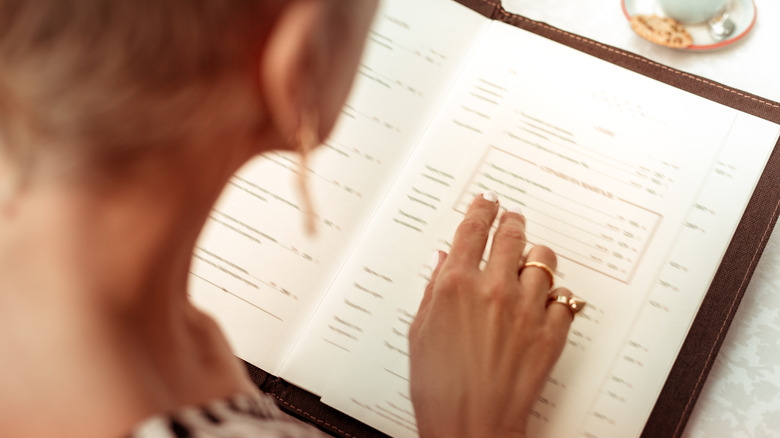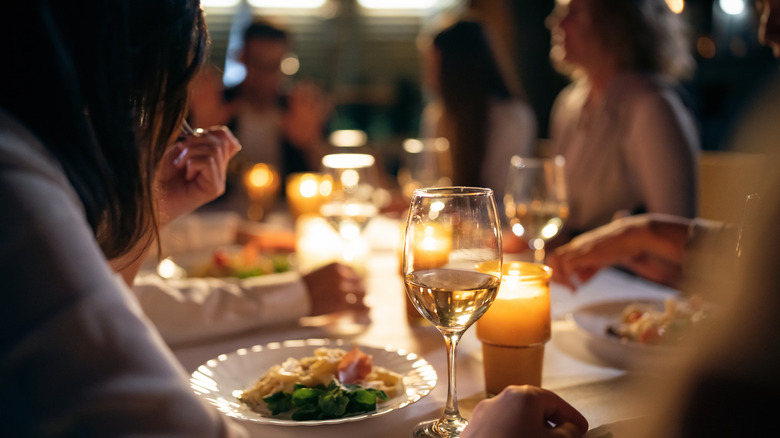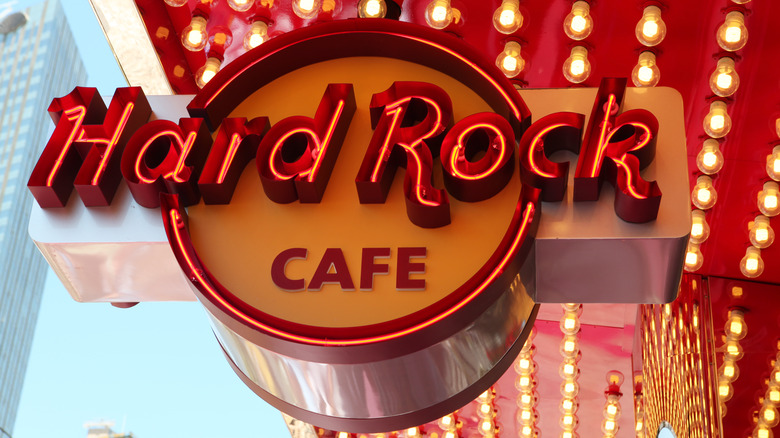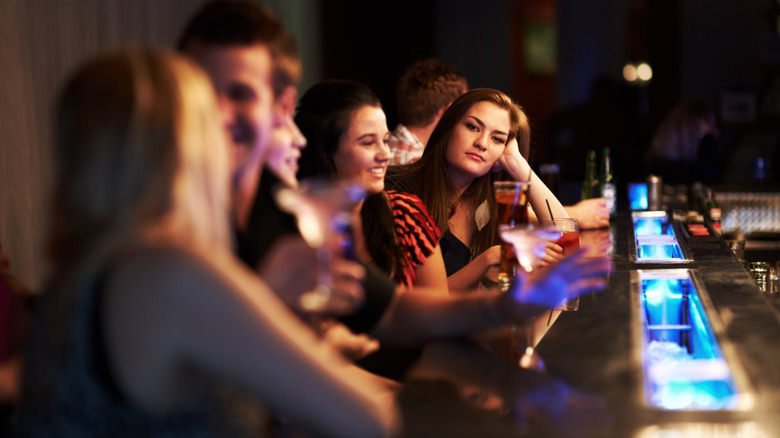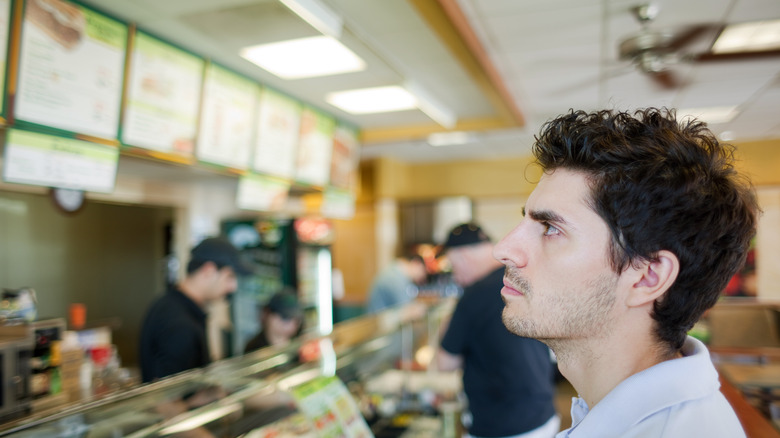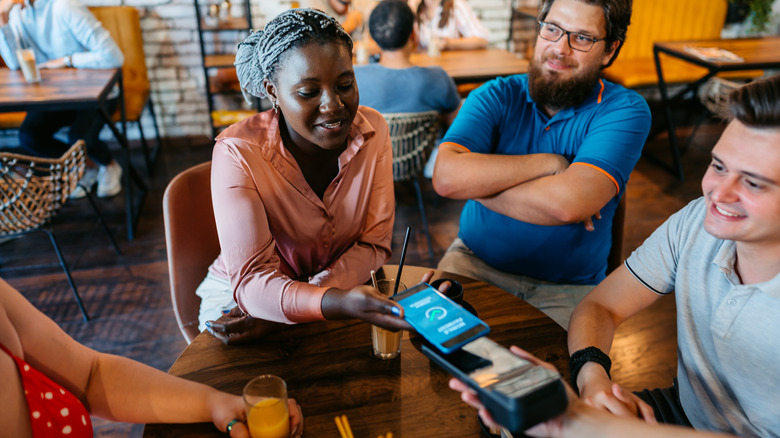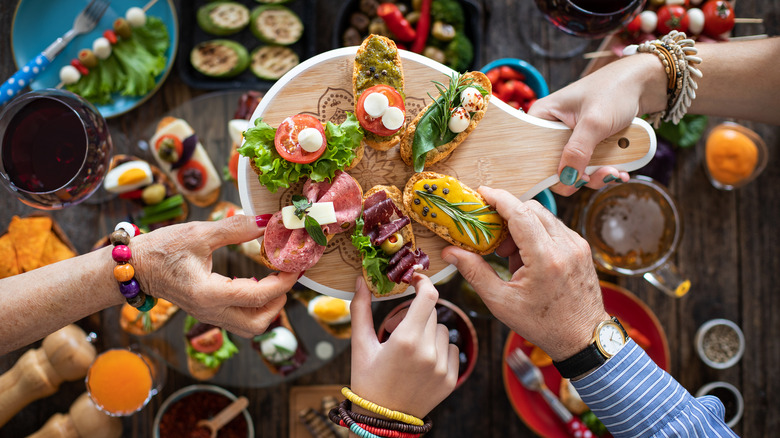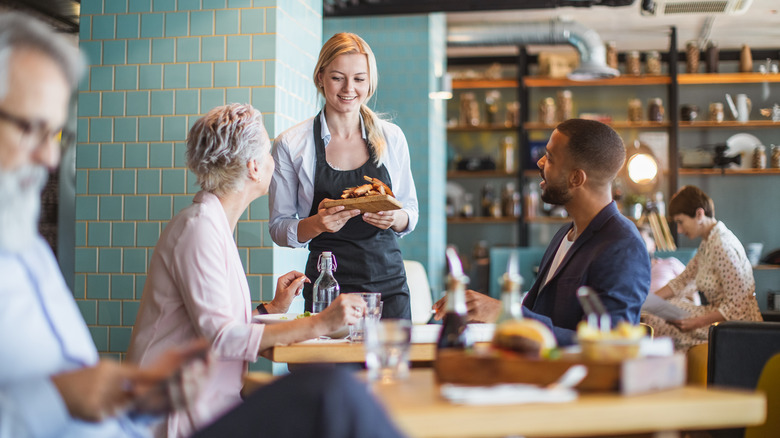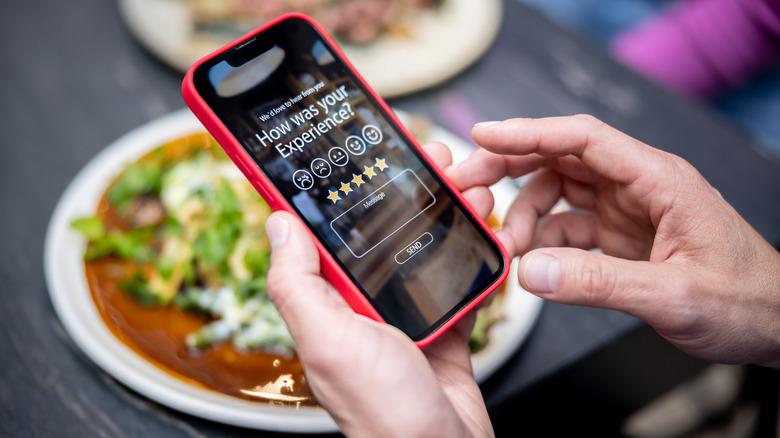12 Tricks Restaurants Use To Make You Spend More
The restaurant business is a notoriously desperate game. While successful restaurants and chains do indeed rake in the cash, you need to rake in an awful lot of it if you plan to remain in business: Margins are shockingly thin, averaging about 7% bottom-line profit across the industry as a whole, according to Aaron Allen & Associates Global Restaurant Consultants. That means the restaurateur needs to take in $1 million to have just $70,000 of profit left at year-end.
That doesn't allow a lot of room for error or inefficiency, as we can attest, having opened and subsequently closed a couple of restaurants. Every restaurateur works within tight constraints; however effective your marketing is, it's only possible to seat and serve a certain number of diners in a day. That means smart operators use every trick in the book to help you spend your money, once you walk in through the door, and that "book" gets bigger every year. Here are some of the top tricks they use, from a former restaurateur who's used a few of them himself.
1. Leading with a high-priced item
Any given menu contains several items at various price points. Putting too many options together is bad psychology (it's too much to think about at once), so usually the menu is divided up into smaller sections that are easier to navigate. They'll usually be segregated by course, type of food, or maybe even by ingredient.
In well-run restaurants, and especially big-money chains that can afford to use consultants, you may notice that the first item in many of those sections is the costliest (or at least, one of the most expensive). Why — you may wonder — would they lead with an item that might make many of us whip out our phones to double-check the balance in our account?
In truth, it's clever psychology and one of the ways restaurants trick you into ordering expensive items. You'll almost always look at that top item on the list, even if you skim the rest of the section; and it's that item that now sets your mental benchmark for the other dishes. Everything that follows will now seem relatively inexpensive, even if it bends your budget because you're unconsciously comparing it with the price of that first dish.
2. Dropping the dollar sign
We all know that eating out means we're going to spend money, and usually, more money than we would have if we'd stayed at home and cooked. But knowing that intellectually is one thing, and experiencing it emotionally is another thing entirely.
That's why the industry pays attention to how it prints prices on the menu. Fast-food chains don't need to sweat this, because their prices are low to begin with, but better-quality restaurants need some help to soften the blow. That's the reason many restaurants don't put dollar signs on the menu.
A 2009 study carried out at Cornell University's Center for Hospitality Research tested menus with and without the dollar sign, and also with the prices written out in text (ie. "Twenty-Five Dollars"). Researchers found that diners given a menu without dollar signs spent noticeably more than those whose menus had the prices written out, or those that had dollar signs. Other factors — the size of the group, and time at the table — had a bigger impact, but the effect of removing dollar signs made it a no-brainer for smart restaurateurs.
3. Using menu language skillfully
A well-trained server can expertly sell what management considers the "right" dishes, meaning the ones that have either a higher price or higher profit margins. Unfortunately, not every server is well-trained or comfortable with selling, so the restaurant's printed menus have to save the day.
This in turn puts a premium on the restaurant's use of language. An influential study published early this century in Advances in Consumer Research found that enticing language influenced diners' perceptions of their food. The highest-impact words and phrases invoked nostalgia ("Grandma's," "Old-Fashioned"), or appealed to the senses ("Sizzling," "Crisp," "Aromatic"). For some diners, giving the meal's ingredients a backstory ("ethically, sustainably raised pastured pork from our own farm"), also improved their perception of the meal and its value.
The study didn't show that menu language directly impacted the amount diners were willing to pay; instead, it improved their perception of the restaurant, its food, and the likelihood that they'd return. That adds up to more revenue for the restaurateur. Applying the most persuasive language to higher-cost or higher-profit menu items can also steer diners in their direction.
4. Setting a mellow groove
Do you have a special playlist for when you've got cleaning to do or want to crank up your heart rate at the gym? If so, you've tapped into another well-established psychological quirk that restaurants use to their advantage.
The simple fact is that the music we listen to affects us in ways we don't always recognize. Up-tempo tunes genuinely do help dial up our heart rates, especially when restaurants blast the music. That's a real bonus for quick-service establishments, where making a profit calls for pushing diners in and out at maximum speed.
In higher-quality restaurants, the goal is exactly the opposite. They want you to "set a spell," and take as much time as you need for a leisurely meal. That's a big reason why fancy restaurants play classical music; aside from reinforcing their upscale aspirations, classical music helps slow you down and make it more likely you'll order an extra course, a dessert, or another bottle of wine. The right music can even make your food taste better.
5. Selling merchandise and branded items
Given that restaurant food is notoriously low-margin, offering non-food items is an obvious way for savvy restaurateurs to coax a few more dollars out of your pocket. The best-known example of that ethos might be the Hard Rock Cafe, where merchandise sales account for a reported 40% of revenues.
Other chains have leaned into merchandise, as well, with Olive Garden, for example, delivering a popular line of holiday merch in 2023. While those examples come from big players in the industry, deep pockets aren't essential to hop onto this trend: Even the smallest of sandwich shops can turn to local providers for inexpensive ball caps, T-shirts, and hoodies. Higher-end establishments might lean instead to kitchenwares, collaborations with local brewers or winemakers, or sell packaged versions of their own sauces or house-made condiments.
A lot of restaurants that might never have ventured into branded merchandise gambled on it as a way to pay the bills during the pandemic, and, as Forbes notes, did well enough that it's now become a staple addition to their business. These ventures don't always pan out, and there's been some especially strange fast food merchandise over the years, but when it works it's pure gravy.
6. Encouraging drinks before dinner
At some restaurants, it's almost automatic that you'll spend a bit of time waiting at the bar before being seated at your table. In others, you may be seated directly at your table, but the helpful server will still make a point of offering wine, or cocktails, or at least the drinks menu, "to get you started."
Encouraging you to enjoy a pre-dinner drink (or two) works heavily in the restaurant's favor. The cocktails or bottles of wine you order immediately pump up the value of the check, and their effect goes well beyond that immediate benefit. The drinks put you in a relaxed and mellow mood, give you a higher level of anticipation for your meal, and may even encourage you to eat more than you otherwise might. If you finish your meal before you finish your bottle, you're also likely to order more wine.
Beverages overall are a huge driver of revenue for restaurants (don't take our word for it, the National Restaurant Association agrees), so you can expect them to continue finding new ways to leverage drinks for added profit. Since the COVID-19 pandemic, they can even be added to to-go orders in many jurisdictions.
7. Bracketing and bundling
You walk into a coffee shop, and the menu offers three sizes. One is a ridiculously large bladder-buster, and one seems a bit small for the price, so you order the middle one. Congratulations, you've just experienced a menu-rigging restaurant trick called bracketing. That middle option is almost invariably the sweet spot where the lines for "most profitable" and "biggest dollar amount" intersect on the coffee shop's spreadsheets.
Restaurants use the same concept to steer you toward their preferred dishes. A burger chain might offer 1-, 2-, and 3-patty versions of their signature burger, for example. Higher-end restaurants are usually subtler, perhaps bracketing a more profitable entrée between one that's a "value" option and one that fetches a price premium (because if you order that, it's also a win).
Bundling takes a different tack, increasing the perceived value of a meal by adding low-cost, high-margin extras. That's why burger chains will always prompt you to "make it a combo" with fries and a drink, rather than ordering a second burger; and why fried chicken chains promote buckets with lots of extra side dishes but little additional chicken. The fine-dining equivalent might offer customized wine pairings with a specific menu because wine by the glass has a huge markup. Whether fast food or fine dining, it's the restaurant equivalent of a retail store's BOGO offers.
8. Bumping up tips with the mobile POS terminal
Coaxing a few more dollars out of your pocket is usually done for the restaurant's direct benefit, but not always. Sometimes putting more money in the server's pocket is the point of the exercise.
Servers are hugely important to a restaurant's success because they are — so to speak — the restaurant's "user interface." A disinterested server can undermine the guest's experience, even if the food is superb; while an outstanding server can make even a run-of-the-mill restaurant feel like a memorable night out. Attracting and keeping top-tier servers is a constant concern for restaurateurs, and one of the biggest selling points they can offer is the prospect of reliably large tips.
This is where the point-of-sale system comes in. That mobile POS terminal your server brings to the table is programmed with pre-set tipping percentages. Many of us will reflexively choose the middle option because we don't want to over-tip but also don't want to be perceived as "cheap." That often makes the tip bigger than we'd intended, so it's one more sneaky way they trick you. In restaurants where portable terminals aren't used, the printed check may do the same by pre-calculating your tip at similar percentages.
9. Featuring small bites that add up to large profits
One of life's truisms is that "little things mean a lot," and that certainly applies in the restaurant world. The small added fee at your favorite fast-food place for extra dips, dressings, or toppings doesn't feel like much when you're placing your order, but collectively they make a satisfying impact on the bottom line.
Remember when it suddenly seemed that every restaurant was offering some form of tasting menu or tapas, or an a la carte selection of jewel-like, one-bite desserts? That's another way restaurants harness psychology to their advantage. Mentally we recognize a single large entrée as a meal, but we're perfectly happy to pick away endlessly at small bites. We've all eaten our body weight in appetizers or charcuterie at parties, right? These "small plates" menus harness the same psychological quirk.
Sure, there's some added labor cost involved in cranking them out, but they make it back on food costs. One serving of filet mignon might become three or four thin-sliced carpaccio, for example, and three small cookies use less dough than one large one. It's worthwhile for the restaurant if it means we'll keep ordering tapas all night, or if — as at Daniel Boulud's restaurant – a small treat becomes a much-loved signature ending to the meal.
10. Pointing you to profitable dishes through menu engineering
The menu in a stereotypical old-school diner was simply a typewritten list of the dishes available (if it existed at all, aside from a chalkboard on the wall). It told you what food was on offer, but little else. A modern menu — at least in any restaurant with the money to hire a consultant — is a much different proposition.
Do you know where people look first, on a menu? Do you know how their eyes follow the page, and what attracts attention? Restaurant consultants do, to a level of detail that might shock you. The process of fine-tuning a menu to maximize its selling potential is known as "menu engineering," and it's gotten to be something of a science.
Once a restaurant works out which of its dishes are the most profitable, everything else on the menu — its colors, its layout, the use of white space, images, even the way the menu uses fonts – is harnessed to the task of steering you subconsciously toward those dishes. It's sneaky, it's brilliant, and it's all but irresistible.
11. Old-fashioned upselling is still a key tactic
A lot of the ways restaurants wheedle a few extra dollars from your pocket could fairly be described as "tricks," or "sneaky," but others are more forthright. The most direct is good old-fashioned upselling.
Upselling can take many forms. Prompting you to buy something else beyond your original order ("Want fries with that?") is the classic upsell, but steering diners toward higher-priced (or higher-margin) items is just as important for a restaurant's bottom line. Experienced servers are really good at this, but "silent sellers" including chalkboard specials, table talkers, and dessert and drinks menus left routinely at the table, whether you ask for them or not, also work, and play a huge role in driving profit at some chains.
Technology has begun to offer a few new opportunities for upselling, in scenarios where it sometimes wouldn't otherwise happen. Drive-thru AI tries to automate both order-taking and upselling, for example, leaving harried staff to focus on the food. That's good for the restaurateur because staff often won't ask. Using work from home drive-thru staff to field the orders (and do the up-selling) is another option that's under active development.
12. Encouraging you to use their app
This is a relatively new thing, and still emerging in the industry, but your favorite restaurant's (or restaurant chain's) app is a seriously powerful tool for extracting money from you. Potentially, a well-designed app can combine all of the usual sneaky restaurant tricks into one slick, glossy package, and apply a few new ones, as well.
The small screen of your phone provides the ultimate in menu engineering, limiting your view to just a handful of options at a given moment. Upselling, bracketing, bundling, the app can do it all. Not only that, but it also lets the restaurant harvest your ordering habits, build a database of your preferences, and — most importantly — provides a method to communicate with you directly.
If their app pings at 11:45 a.m. with the news that there's a promotion on your favorite dish, and that they can have it to your office in 10 minutes with just one click, are you likely to make the order? Oh, yeah. Some apps are better than others, obviously, but even a mediocre app gives restaurants the leverage they need to coax more money from you.
